Understanding Echolalia and Its Role in Autism
Echolalia is a common characteristic observed in children with autism spectrum disorder (ASD). It involves the repetitive display of words or phrases that a person has heard, serving various functions in communication and self-regulation. While echolalia can be part of typical toddler language development, its persistence beyond early childhood or when it appears in adolescence and adulthood may indicate underlying developmental challenges. Recognizing and understanding echolalia is essential for implementing effective interventions.
What Is Echolalia and How Does It Present in Children with Autism?
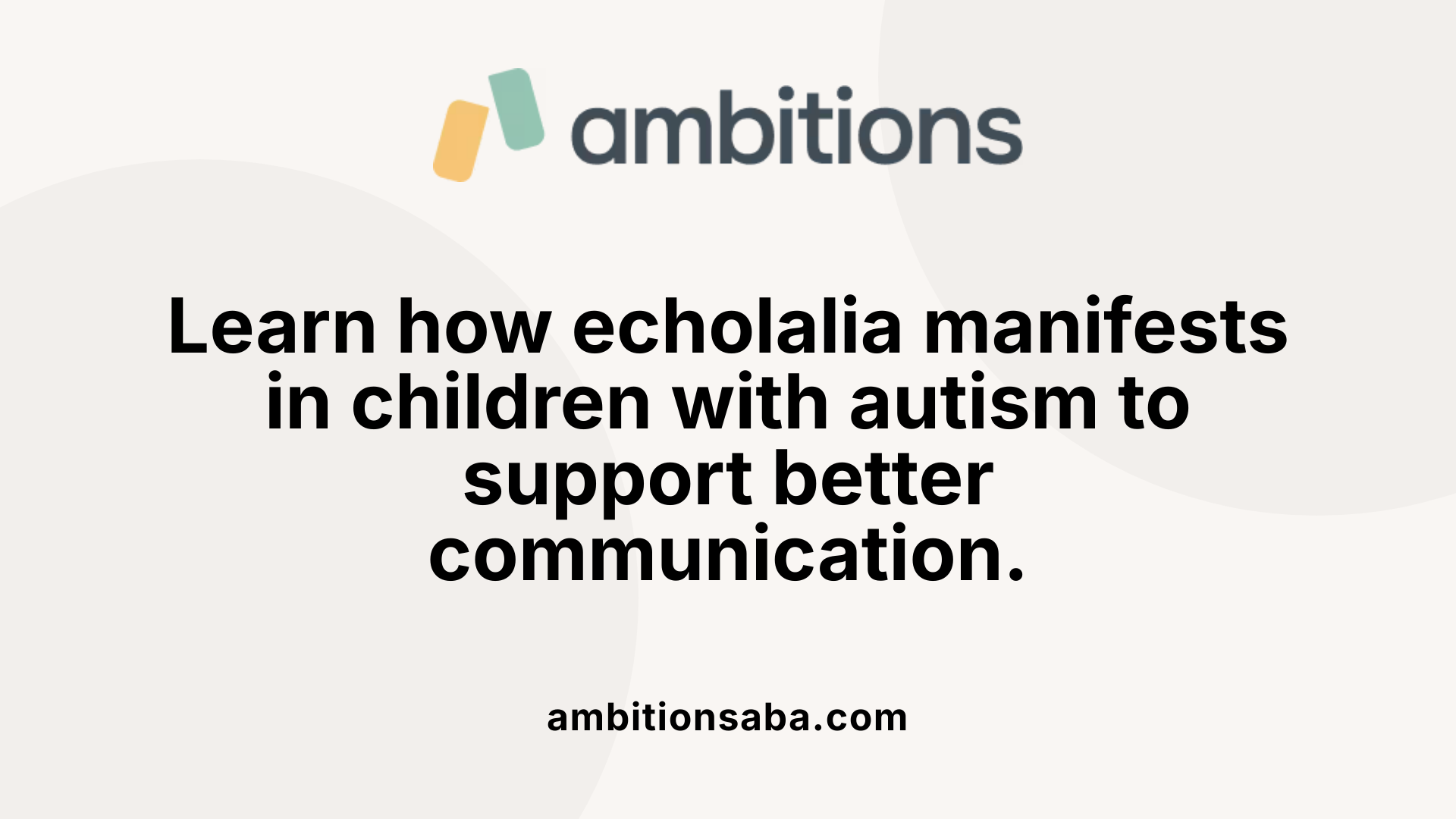
What is echolalia and how does it present in children with autism?
Echolalia is the repetition of words or phrases that a person has heard, and it is commonly observed in children with autism spectrum disorder (ASD). It can happen in different ways, such as immediate echolalia, where a child repeats what they just heard right away, or delayed echolalia, where the repetition is from earlier experiences, sometimes out of the current context.
Children with autism often use echolalia as a part of their communication attempts. Sometimes, they repeat phrases to start or continue conversations, ask for something, or respond in social interactions. Other times, echolalia serves self-stimulatory or comforting functions, helping children self-regulate or process language.
While echolalia is a normal part of language development in very young children, especially toddlers, it can persist beyond age 3 in children with autism. When this occurs, it may indicate different developmental challenges or serve adaptive purposes related to learning and social engagement.
Understanding how echolalia manifests helps caregivers and educators support children in developing more spontaneous and meaningful communication. Therapeutic techniques like speech therapy and Applied Behavior Analysis (ABA) aim to promote functional speech and reduce reliance on echoing, while recognizing its role in the child's language processing.
Types of echolalia
- Immediate echolalia: Repeating phrases immediately after hearing them.
- Delayed echolalia: Repeating phrases after a time lag, often from conversations, media, or previous experiences.
How it appears in behavior
- Using repeated phrases to ask for help or express needs.
- Engaging in repetitive speech for self-stimulation.
- Responding to questions with echoed words.
- Using script-like language from familiar routines or media.
In summary, echolalia in children with autism is not just random repetition. It often reflects attempts to communicate, process language, or self-soothe. Recognizing its forms and functions allows for better support strategies, whether through targeted therapies or environmental adjustments.
Causes and Underlying Reasons for Echolalia in Autism
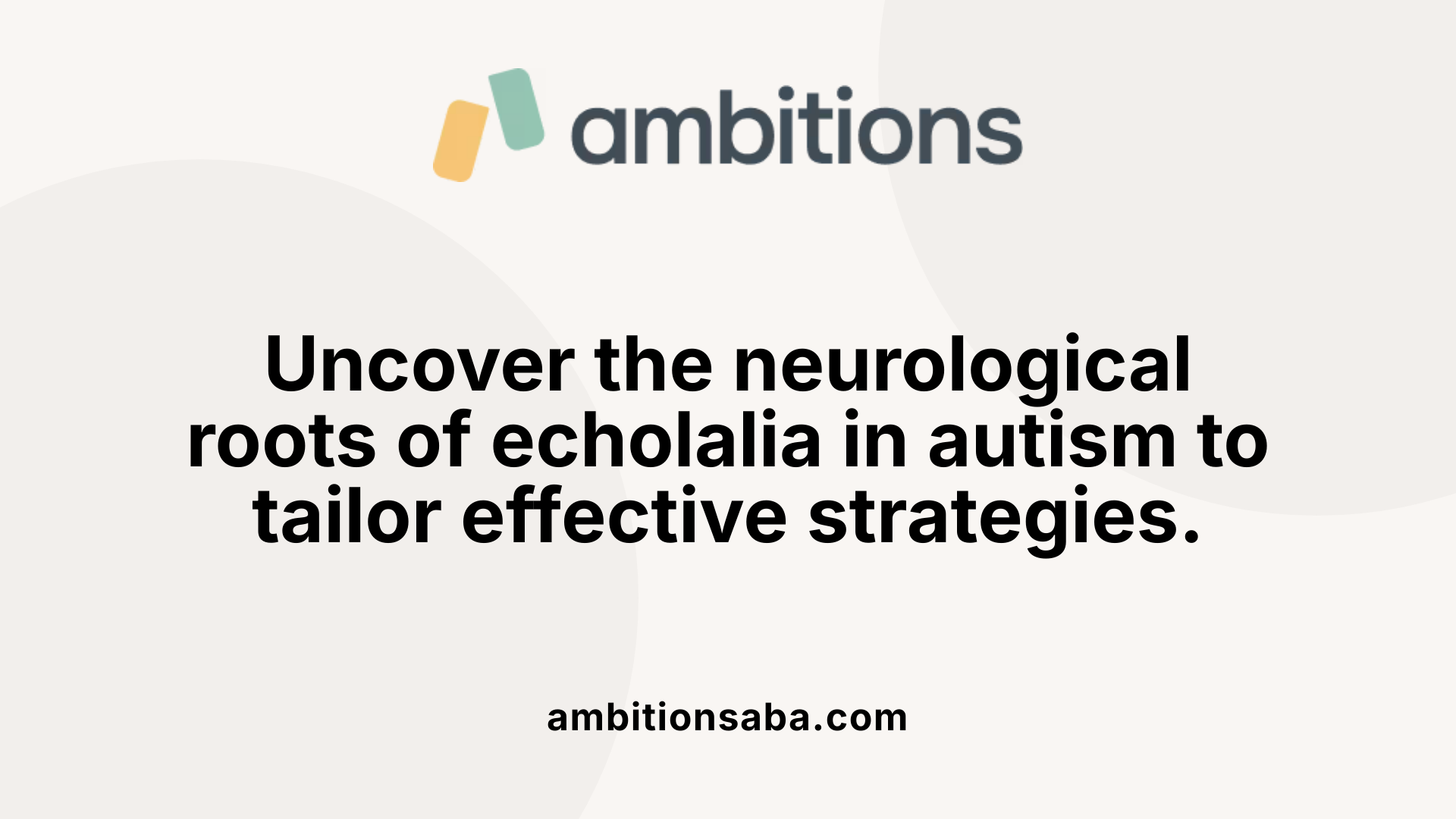
What are the causes and underlying reasons for echolalia in children with autism?
Echolalia in children with autism often stems from disruptions in the brain regions responsible for language and social processing. Specifically, areas such as the frontal lobe and the mirror neuron system—which helps in understanding and mimicking actions—may function atypically. This neurological difference can hinder spontaneous speech creation, leading children to repeat words or phrases instead.
The behavior might also be influenced by neurochemical factors, such as dopamine dysregulation. Dopamine, a chemical involved in reward and motivation, may impact how children reinforce or seek comfort from certain sounds or phrases. These imbalances can contribute to repetitive behaviors like echolalia.
Functionally, echolalia serves multiple roles for children with autism. It can act as a form of self-stimulation, providing comfort through repetitive sounds or phrases. It also offers a way for children to practice language, helping them understand how words are used in context, which is especially vital when their spontaneous speech is limited.
Moreover, echolalia allows children to communicate needs, initiate interactions, or draw attention. For some, it is a way to manage emotional responses or navigate social scenarios. It may also be a response to environmental stimuli—like a familiar phrase heard in media or from caregivers—that the child mimics to process or engage with their surroundings.
Underlying conditions such as autism spectrum disorder (ASD), Tourette syndrome, or other neurological or developmental disorders can increase the likelihood of echolalia. These conditions often involve challenges in language development and social communication, making repeated speech a strategy to compensate for difficulties in spontaneous language use.
Overall, echolalia reflects a blend of neurological, developmental, and environmental factors. It often serves as a stepping stone toward more functional communication, encapsulating the child's efforts to understand, process, and interact with the world around them despite their challenges.
Assessment and Evaluation of Echolalia in ABA Therapy
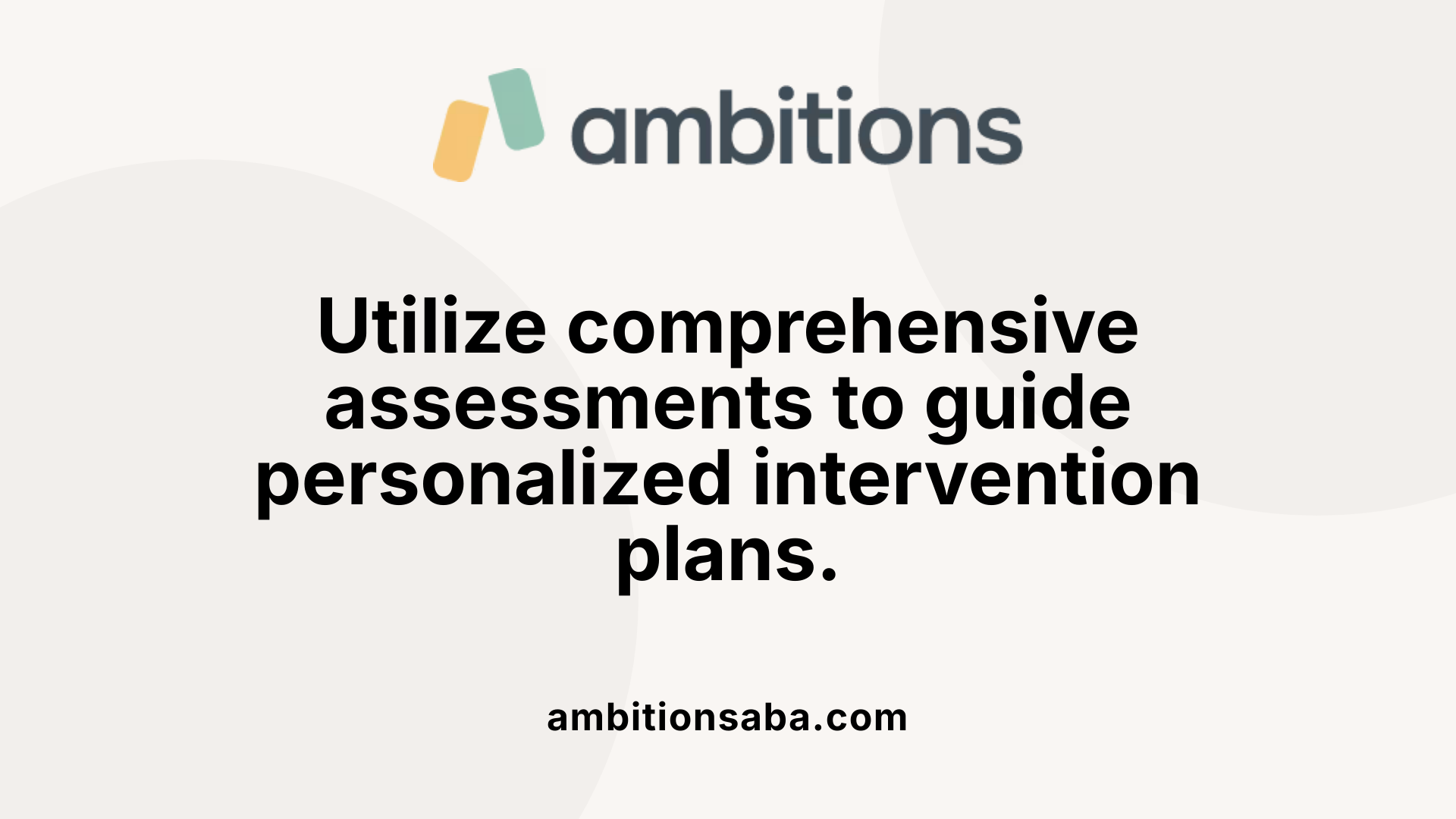
How does ABA therapy assess and evaluate echolalia in children?
ABA (Applied Behavior Analysis) therapy involves a thorough process to understand how and why children with autism engage in echolalic speech. The initial step often includes detailed observation and systematic data collection. Practitioners record how frequently the child repeats words or phrases, noting whether the echolalia occurs immediately after hearing (immediate) or at a later time (delayed). They also determine the context in which the repetitions happen and if they serve specific functions, such as self-stimulation, expressing needs, or initiating social interactions.
To gather comprehensive information, clinicians use various tools. Caregiver reports are essential, as they provide insights into the child's communication patterns across different settings. Functional behavior assessments (FBAs) help identify triggers and purposes behind echolalic responses. Additionally, standardized speech and language evaluations are conducted to measure the child's communicative abilities and differentiate between functional and non-functional echolalia.
This detailed assessment helps clinicians develop individualized intervention plans. By understanding specific behaviors—like whether echolalia is mitigated or unmitigated—and pinpointing its social or self-regulatory roles, therapists can tailor strategies to reduce harmful repetitions and promote spontaneous communication.
Assessment is an ongoing process. Regular data collection allows progress tracking and helps refine intervention techniques. The goal is to foster more flexible, purposeful language that children can generalize across different environments and social contexts.
Types and functions of echolalia assessed
Echolalia exists in various forms, each serving different functions. Immediate echolalia occurs right after hearing a phrase, often serving as a way for children to process language or self-soothe. Delayed echolalia involves repeating phrases heard earlier, which can help children recall language or cope with anxiety.
Functionally, echolalia can serve as a way for children to express needs, initiate conversations, or request attention. It may also function as self-stimulation or provide comfort during stressful moments. Recognizing these functions allows therapists to differentiate between repetitive behavior that hinders communication and that which supports it.
Use of caregiver reports and standardized tools
Caregivers play a vital role in the assessment process. Their observations help paint a full picture of the child's echolalic behaviors, especially in natural settings like home or school. Caregiver reports include detailed descriptions of when and how echolalia occurs, along with the child's responses to different interventions.
Standardized tools, such as speech and language assessments, help measure the child's overall language development and identify specific areas for targeted therapy. Functional behavior assessments also provide insight into the environmental factors influencing echolalia.
Both caregiver feedback and standardized assessments inform a comprehensive understanding of the child's communication profile. This integrated approach guides individualized therapy goals and supports the development of functional communication skills.
| Assessment Method | Focus | Key Features | Purpose |
|---|---|---|---|
| Observation & Data Collection | Frequency, type, context | Quantitative tracking of behaviors | Determine patterns and triggers |
| Caregiver Reports | Real-life behavior insights | Descriptions of daily behavior | Capture naturalistic behaviors |
| Standardized Tools | Language skills | Formal measurement of communication | Identify developmental levels |
| Functional Behavior Assessment | Functions of echolalia | Analyzing triggers and purposes | Develop targeted interventions |
Understanding and accurately assessing echolalia through these methods enable clinicians to implement effective, personalized strategies aimed at increasing functional communication and reducing non-purposeful repetitions.
The Process of ABA Therapy for Managing Echolalia
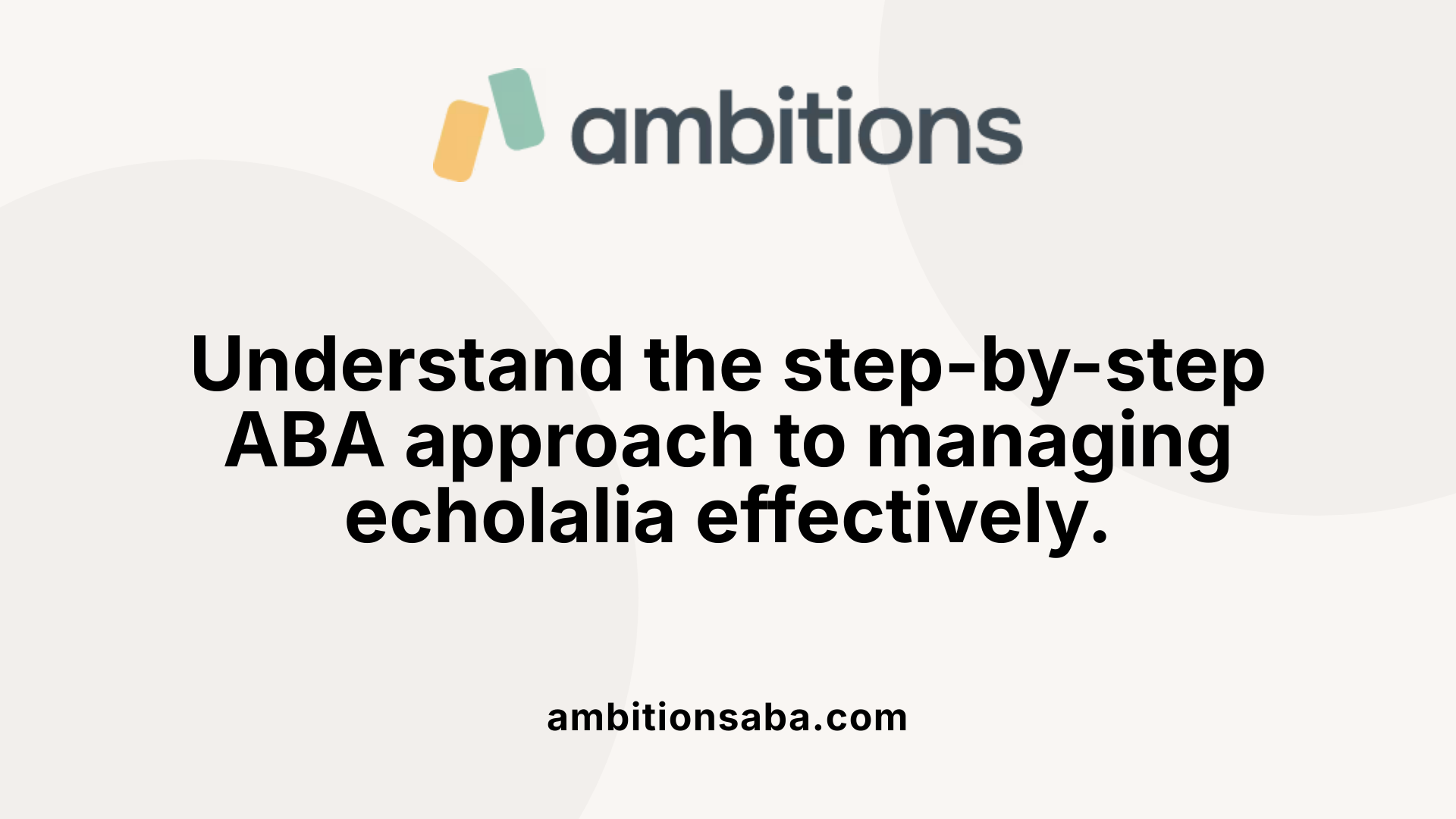
What is the process involved in ABA therapy for managing echolalia?
ABA therapy for managing echolalia begins with a thorough assessment conducted by behavior analysts or multidisciplinary teams. This initial step aims to understand the specific types of echolalia the child exhibits—whether it’s immediate, delayed, or a combination—and to identify its underlying functions. The assessment also involves observing the contexts and triggers for the repetitive speech to determine if it serves purposes like self-stimulation, communication, or self-soothing.
Based on the assessment results, clinicians establish individualized, functional communication goals. These goals focus on helping the child develop meaningful ways to express needs, initiate interactions, or participate socially. The goal setting involves selecting appropriate interventions tailored to each child's motivations and developmental level.
Interventions in ABA therapy include a variety of techniques such as cues-pause-point training, script training, prompting, modeling, and reinforcement. Cues-pause-point training involves providing specific cues or prompts to guide the child in producing desired responses, while script training helps children practice situationally relevant phrases to improve spontaneous language.
Prompting methods, like visual or verbal cues, assist children in developing appropriate responses, gradually fading as the child gains mastery. Reinforcement strategies reward the child’s efforts and successes—whether through praise, preferred activities, or tangible rewards—to motivate continued progress.
Throughout therapy, continuous monitoring is essential. Progress is tracked regularly, with clinicians rechecking foundational skills and mastery of targeted behaviors. This ongoing evaluation allows for adjustments in intervention strategies to ensure they remain effective and suited to the child's evolving needs.
A vital aspect of the process is understanding the function of echolalia—whether it’s used for self-monitoring, answering questions, or gaining attention—that guides the selection of specific techniques within the broad ABA framework. Overall, this structured approach aims to reduce nonfunctional repetition and promote spontaneous, purposeful communication, helping children generalize these skills across settings and social environments.
Expected Outcomes and Benefits of ABA Intervention

What are the expected outcomes and benefits of ABA therapy in reducing echolalia and enhancing communicative skills?
Applied Behavior Analysis (ABA) therapy has shown to be highly effective in addressing echolalia in children with autism. One primary goal of ABA is to diminish the frequency of repetitive, echo-like speech patterns, guiding children towards using more purposeful, spontaneous forms of communication. Through individualized strategies, ABA therapists help children replace echolalic speech with functional language that makes sense in social contexts.
Techniques such as prompting, modeling correct responses, and incorporating alternative communication methods like AAC devices are central to ABA approaches. These tools support children in initiating conversations, understanding nonverbal cues, and developing social language skills.
In addition to improving speech patterns, ABA therapy aims to enhance overall communication. Children learn to express their needs more clearly, respond appropriately in conversations, and participate actively in social interactions. Such improvements often lead to increased independence in daily activities and social settings.
Beyond communication, ABA therapy also contributes to reducing maladaptive behaviors that may serve as self-stimulatory or soothing activities. As children develop more appropriate ways to express themselves, behaviors like self-injury or tantrums tend to decrease.
Overall, ABA therapy offers tangible benefits. It helps children develop lasting, practical communication skills that extend into natural environments such as home and school. As a result, children with autism are better able to engage with others, foster friendships, and participate more fully in community settings.
Intervention Strategies and Techniques in ABA for Echolalia
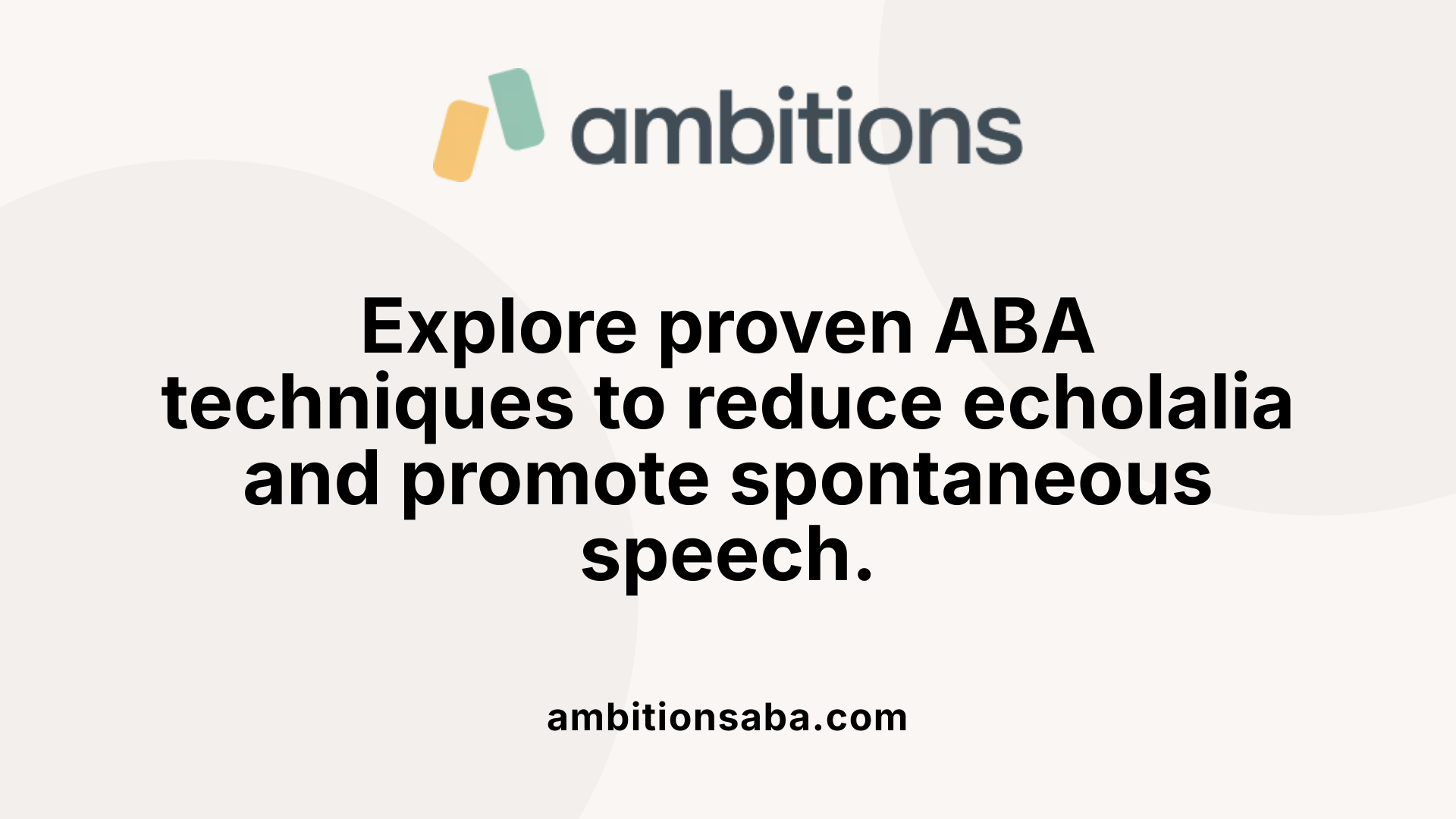
What intervention strategies does ABA use to address echolalia, including techniques like tact training and the cues-pause-point method?
Applied Behavior Analysis (ABA) employs a range of strategies to help children with autism reduce echolalia and develop more functional communication skills. One widely used technique is tact training, where children learn to produce appropriate labels or comments in response to specific stimuli. For example, a child might be encouraged to say “ball” when seeing a ball, rather than repeating sounds or phrases heard elsewhere.
Another effective method is the cues-pause-point technique. This involves giving a prompt or cue to the child, then pausing to allow the child to respond independently. If the response is correct, it is reinforced, which promotes spontaneous speech instead of rote repetition. This structured approach helps children understand when and how they should produce meaningful language.
Visual supports—including picture cards, communication boards, and other aids—are also integral. These tools serve as prompts and reinforce understanding, especially when combined with verbal modeling. Modeling involves demonstrating the desired speech or behavior in simple, clear language.
Reinforcement strategies further support progress. Positive reinforcement rewards appropriate responses, such as spontaneous comments or reduced echolalia, motivating children to continue developing their communication skills. Differential reinforcement involves reinforcing more appropriate behaviors while lessening attention to less functional echolalic speech.
Fading prompts gradually is another crucial step. This process involves reducing the level of assistance over time, encouraging the child to produce responses with less help, fostering independence.
These components form a comprehensive approach aimed at helping children communicate more purposefully, transitioning from repetitive speech to meaningful, spontaneous language. Combining tact training, cueing techniques, visual supports, and reinforcement creates an effective framework for addressing echolalia in children with autism.
Supporting Children with Echolalia: Parental and Caregiver Strategies

How can parents and caregivers support children with echolalia through ABA-guided strategies?
Supporting children with echolalia involves understanding its functions and applying targeted strategies to promote meaningful communication. Behavioral interventions based on Applied Behavior Analysis (ABA) form the backbone of effective support.
Firstly, an initial assessment is essential. This helps identify the specific type of echolalia — whether immediate or delayed — and the reasons behind it, such as self-regulation, social interaction, or language learning.
Once the assessment is complete, parents and caregivers can implement reinforcement techniques. Positive praise and rewards for spontaneous or functional speech motivate children to develop their communication skills. For example, when a child attempts to use a word instead of echoing, praising their effort encourages continued progress.
Modeling correct language is also critical. Using simple, clear phrases and avoiding complex questions helps children imitate appropriate responses. Visual supports, such as picture cards or visual schedules, make language more accessible and provide cues for expressing needs.
Using prompting strategies—like verbal cues, gestures, or visual prompts—guides the child towards more appropriate responses. Over time, prompts are systematically faded to foster independence in communication.
Alternative communication devices, including Picture Exchange Communication System (PECS) and augmentative and alternative communication (AAC) tools, empower children to express themselves without relying solely on echolalia.
Establishing consistent routines and simplifying language within the child's environment create predictable interactions that encourage language use. Combining these approaches with patience and understanding fosters a supportive learning atmosphere.
Collaboration with professionals—speech therapists and ABA specialists—is vital. These experts can tailor interventions, guide prompt fading, and help set realistic goals.
Ultimately, the goal is to help children transition from echolalic speech to spontaneous, purposeful communication. Gradually, as children learn to express their needs and thoughts directly, their reliance on repetitive phrases decreases.
By integrating these strategies into daily routines and maintaining a supportive environment, parents and caregivers play a crucial role in fostering language development and enhancing quality of life for children with echolalia.
Monitoring and Evaluating Progress in ABA Interventions
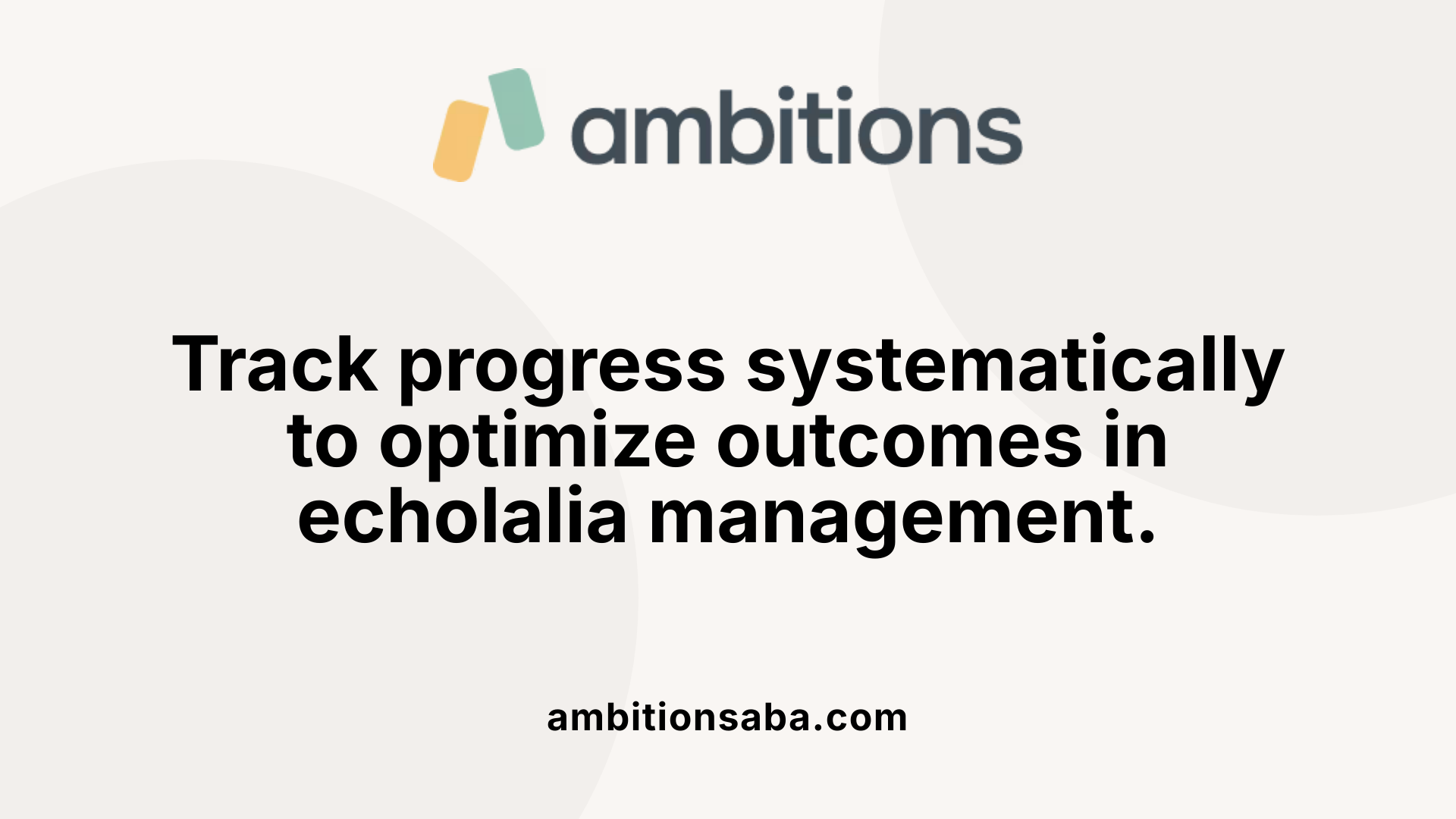
How is progress monitored and evaluated in ABA interventions for echolalia?
Tracking progress is an essential part of ABA therapy for children with echolalia. Therapists gather systematic data on how often and in what contexts the child's repetitive speech occurs. This information includes details like the frequency of echolalic responses, their types (immediate or delayed), and the situational triggers.
To assess communication abilities more objectively, standardized tools such as the Verbal Behavior Milestones Assessment and Placement Program (VBMAPP) and the Assessment of Basic Language and Learning Skills (ABLLS) are often employed. These assessments help measure a child's verbal, social, and academic skills at different stages of treatment.
Therapists regularly observe whether the child is making functional improvements, such as initiating spontaneous speech, successfully using communication tools, or decreasing maladaptive repetition. This ongoing evaluation allows for adjusting therapy goals and techniques.
Adjustments may include modifying prompts, fading strategies, or reinforcement schedules to better meet the child's evolving needs. Focusing on practical outcomes like increased use of purposeful language or reducing reliance on echolalic responses guides goal setting.
Collaboration with parents, caregivers, and other team members ensures that intervention strategies are consistent across settings. This teamwork supports the child's generalization of skills and promotes sustained communication growth.
Ultimately, monitoring progress through detailed data collection and standardized assessments ensures that ABA therapy remains effective and tailored, continually fostering meaningful communication development in children with echolalia.
Empowering Children to Communicate Effectively
Through tailored assessment and evidence-based interventions, ABA therapy plays a crucial role in helping children with autism manage echolalia. By understanding the behavior’s functions and applying specific strategies such as tact training, visual supports, prompting, and reinforcement, therapists can guide children toward spontaneous and meaningful communication. Parental involvement and consistent monitoring of progress are vital in ensuring sustainable development. As children learn to communicate more effectively, they experience improved social interactions, greater independence, and a higher quality of life, making ABA an invaluable tool in addressing the complexities of echolalia in autism.
References
- Understanding Echolalia in Autism: Why It Happens and How to Help
- How ABA Therapy Addresses Echolalia in Children | Unique Pathways
- The Effects of Tact Training on Echolalia in Children with Autism ...
- Echolalia and Autism - Golden Care Therapy
- Echolalia in Children with Autism, What It Is and How to Support ...
- Echolalia - StatPearls - NCBI Bookshelf
- How ABA Therapy Addresses Echolalia in Children | Unique Pathways
- A systematic review of interventions for echolalia in autistic children



